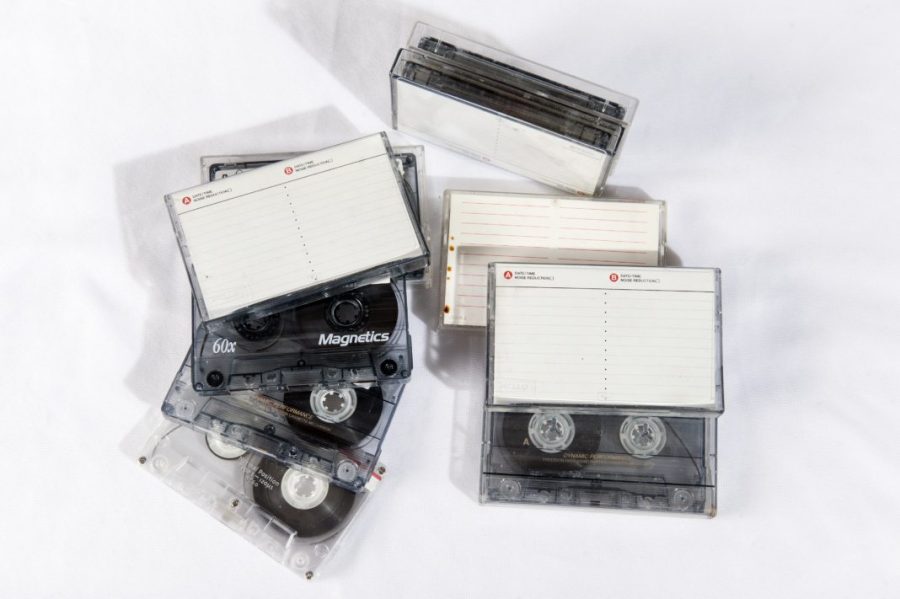
Cassette tapes in Salt Lake City, UT on Wednesday, Feb. 14, 2018 (Photo by Adam Fondren | Daily Utah Chronicle)
A note before I get started: I have both been severely depressed and have received a goodbye message from a friend contemplating suicide. These experiences inform my opinion, and I am not going to be shy discussing this content.
The netflix series “13 Reasons Why” is the story of Hannah Baker. She is a the standard American teenager whose parents move her to a new school starting her sophomore year of high school. The show traces her experiences through the start of her junior year, at which point she kills herself. She starts out happy, flirty and average, with a job at the movie theater and relatively good grades, but through bullying and a series of parties and letdowns, she ends up feeling so completely alone she commits suicide.
All of her reasons for killing herself are based off of feelings. Yes, Baker is bullied, she is even raped at one point and also witnesses a rape, and none of those things are okay. And the way the show handled them also wasn’t okay.
Revenge Suicide
“13 Reasons Why” is an interesting, definitely binge worthy show about a concept called revenge suicide. Here’s the thing; suicide is by definition a choice. According to the Oxford English Dictionary, suicide is “one who dies by his own hand; one who commits self-murder.” Now, many people are driven to suicide by external factors: losing a job, divorce, depression and so on, but Hannah commits suicide in order to get back at the people she feels betrayed her. She makes 13 cassette tapes and has another student distribute them. The first tape explains each person must listen to all of the tapes and then pass them on to the next person. If they don’t, a third party will release the tapes, insinuating everyone will know how these 13 people killed Hannah.
On each tape, a different person is blamed for something. Their transgressions range from taking pictures and making lists to rape. One person simply doesn’t follow her out the door after she said she was fine. This is the first problem with the show. By putting all of these acts in the same category, it trivializes crimes and villainizes acts of stupidity. One guy asks Hannah out three times over the course of the show, but distrustful Hannah doesn’t just turn him down, she screams at him to get away from her in the school cafeteria.
In revenge, he steals notes out of her compliment bag. The show equates this encounter to be of equal gravity to raping Hannah in a hot tub. Zach, the compliment-stealer, is just as guilty for Hannah’s death as Bryce, a serial rapist. The main character of the show, Clay, is guilty of nothing more than loving Hannah. He was the lone bright spot in her life toward the end, yet he is blamed because one night when they were both drunk at a party, Hannah yells at him to go away when they were making out. Naturally, he left. Clay is one of the most devastated characters in the show and almost kills himself.
Sending the Wrong Message
The show is essentially saying suicide is okay if it has a purpose — that you should kill yourself with the intention of causing others to do the same. I’m sure there are people who would say it was never Hannah’s intention to cause anyone else to die. However, it was my impression from the very first tape she wanted them to feel as awful as she did, and she succeeds. Clay nearly kills himself, Justin leaves home to live on the streets with a bottle of booze and a gun, Jessica starts a relationship with her rapist and Alex shoots himself in the head. What a nice ending, and what lovely effects Hannah’s death and tapes had on her classmates.
Furthermore, Hannah blames several characters for not doing the right thing. No one came forward to report Jessica’s or Hannah’s rapes, and Sheri didn’t report she knocked down a stop sign that caused another character to die. Hannah is greatly upset by what she considers the failure of all these other characters, but there is a hole in her plot. She never reports it either — any of it. In fact, Hannah is worse than any of the others because she knew about all of it and never said a word — not to her parents, not to the school and not to the police.
“13 Reasons Why” is brave because in the final episodes it depicts the entire process of Hannah killing herself. Viewers watch her buy the razors, change clothes, run a bath, get in, slit her wrists, cry and sigh as the water turns dark red. It is quite the image and fully intended to scare teens out of commiting suicide. However, organizations that actually work to reduce the stigmas around suicide, bullying and rape, don’t condone this depiction and neither do survivors.
The problem with this show is twofold. Though it may reduce stigma around the things Hannah goes through, it doesn’t present any healthy ways to deal with these issues. Even Hannah’s victims — that is what they are — don’t deal with the tapes appropriately. Killing yourself to victimize others and potentially drive them to death, too, is not a healthy coping mechanism under any circumstances.
The second problem is the scene where Hannah kills herself is graphic, but it’s not graphic because it’s dirty, gritty and desperate — as it should be. It’s graphically beautiful.
The bath runs a dark red against a white and pink backdrop, the music is soft and slow and Hannah sighs as she dies because it is finally over. This is release and salvation. The only thing that’s not pretty in the final tableau is Hannah’s old gray shirt. The moment her mother runs in to cradle her daughter and cry is devastating, but not in “this little girl will never have a life” kind of way, it’s more “look at this gorgeously sad woman in her lovely navy dress which slowly soaks up the bloody water of her daughter’s final moments.” It’s metaphoric, not realistic, and for those who have been there, who have gotten the final goodbye or sat down in the bathtub, it completely forgets the fear. The moment at which you realize someone is going to be gone from your life forever is one of the most terrifying things you can ever experience. It eclipses all else, and it’s not pretty, lovely or devastating. It’s heartstopping and terrible.
Killing yourself is the worst possible thing you can do to the people who love you and while you can see that in the show, in that final moment it’s missing from the eyes of Hannah’s mother. There is much more than grief; loss is also fear and anger.
Starting a Conversation
“13 Reasons Why” did a lot wrong, but it did open the door to conversations about suicide, rape and bullying. Within the past month, two different suicide attempts at the University of Utah were reported. These are real issues we need to talk about, but not the way this show addresses them.
If you or a loved one is contemplating suicide, contact the National Suicide Prevention Lifeline at 1-800-273-TALK, or consult any of the available resources on campus: the University of Utah’s Counseling Center or you can use the SafeUT app to reach someone immediately.
letters@chronicle.utah.edu
@TheChrony
